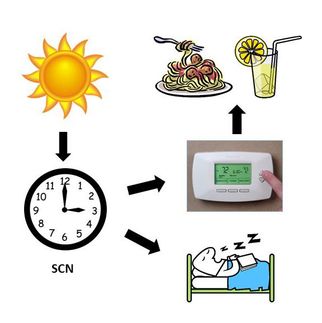Scientists create compounds that dramatically alter biological clock and lead to weight loss
The new molecules could lead to unique treatments for obesity, diabetes, high cholesterol, and sleep disorders
Scientists from the Florida campus of The Scripps Research Institute have synthesized a pair of small molecules that dramatically alter the core biological clock in animal models, highlighting the compounds' potential effectiveness in treating a remarkable range of disorders — including obesity, diabetes, high cholesterol, and serious sleep disorders. The study was published in Nature.
The study showed that when administered in animal models the synthetic small molecules altered circadian rhythm and the pattern of core clock gene expression in the brain's hypothalamus, the site of the master cellular clock that synchronizes daily rhythms in mammals; circadian rhythms are the physiological processes that respond to a 24-hour cycle of light and dark and are present in most living things.
When given to diet-induced obese mice, these same small molecules decreased obesity by reducing fat mass and markedly improving cholesterol levels and hyperglycemia — chronically high blood sugar levels that frequently lead to diabetes.
"The idea behind this research is that our circadian rhythms are coupled with metabolic processes and that you can modulate them pharmacologically," said Thomas Burris, a professor at Scripps Florida who led the study. "As it turns out, the effect of that modulation is surprisingly positive — everything has been beneficial so far."
Burris stressed that these compounds were first generation — the first to hit their targets in vivo with room for improvement as potential treatments. "In terms of therapeutics, this is really the first step," he said.
In the new study, the team identified and tested a pair of potent synthetic compounds that activate proteins called REV-ERBα and REV-ERBβ, which play an integral role in regulating the expression of core clock proteins that drive biological rhythms in activity and metabolism.
In the study, the scientists observed clear metabolic effects when the synthetic compounds were administered twice a day for 12 days. Animals displayed weight loss due to decreased fat mass with no changes in the amount of food they ate. The animals followed the human model of obesity closely, eating a standard Western diet of high fat, high sugar foods, yet still lost weight when given the compounds.
In one of the study's more striking findings, both synthetic compounds were shown to reduce cholesterol production. Cholesterol in the blood of treated animal models decreased 47 percent; triglycerides in the blood decreased 12 percent.
The circadian pattern of expression of a number of metabolic genes in the liver, skeletal muscle, and in fat tissue was also altered, resulting in increased energy expenditure, something of a surprise. In the study, the scientists observed a five percent increase in oxygen consumption, suggesting increased energy expenditure during the day and at night. However, these increases were not due to increased activity — the animals displayed an overall 15 percent decrease in movement during those same time periods.
In addition to its impact on metabolism, the two compounds also affected the animals' activity during periods of light and darkness, suggesting that this class of compound may be useful for the treatment of sleep disorders, including the common problem of jet lag.
Most read news
Organizations
Other news from the department science

Get the life science industry in your inbox
By submitting this form you agree that LUMITOS AG will send you the newsletter(s) selected above by email. Your data will not be passed on to third parties. Your data will be stored and processed in accordance with our data protection regulations. LUMITOS may contact you by email for the purpose of advertising or market and opinion surveys. You can revoke your consent at any time without giving reasons to LUMITOS AG, Ernst-Augustin-Str. 2, 12489 Berlin, Germany or by e-mail at revoke@lumitos.com with effect for the future. In addition, each email contains a link to unsubscribe from the corresponding newsletter.



















































